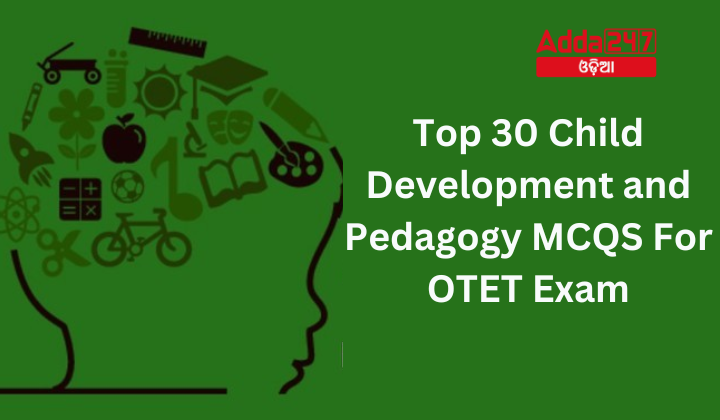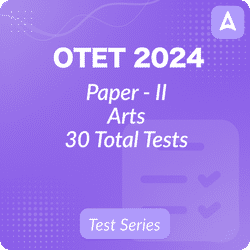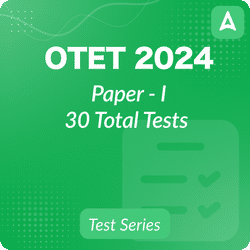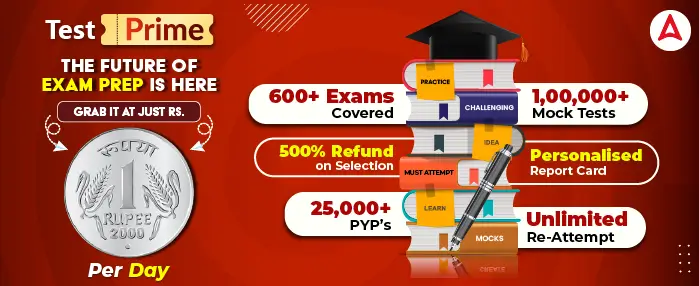The Odisha Teacher Eligibility Test (OTET) assesses the eligibility of candidates to teach in schools of Odisha. A crucial section of this exam is Child Development and Pedagogy, which evaluates understanding of child development and the principles of pedagogy. Below are 30 multiple-choice questions (MCQs) designed to help candidates prepare for this section.
Top 30 Child Development and Pedagogy MCQS For OTET Exam
- Children acquire gender roles through all of the following except:
(a) socialization
(b) culture
(c) tutoring
(d) media
Answer: (c) - One of the critiques of standardized tests has been that:
(a) their language is difficult to understand
(b) the tests cannot be administered on large populations
(c) they do not give a clear picture of a child’s ability
(d) they represent largely the mainstream culture and are therefore biased
Answer: (b) - The theory of multiple intelligence says that:
(a) intelligence can be of several kinds
(b) paper-pencil tests are not helpful
(c) intelligence can be multiplied with effective pedagogy
(d) intelligence can be rapidly accelerated
Answer: (a) - Teachers can utilize both assessment for learning and assessment of learning to:
(a) know the learning needs of the child and select teaching strategies accordingly
(b) assess the child’s performance at periodic intervals and certify his/her performance
(c) monitor children’s progress and set appropriate goals to fill their learning gaps
(d) know children’s progress and achievement levels
Answer: (d) - Which one of the following is not related to Continuous and Comprehensive Evaluation?
(a) It is an integral part of the teaching-learning process.
(b) It focuses on a child’s achievement in different learning areas.
(c) It is useful to label children as slow, poor, or intelligent.
(d) It has been mandated by the Right to Education Act of India.
Answer: (c) - Giftedness in children can be attributed to:
(a) a resource-rich environment
(b) successful parents
(c) a disciplined routine
(d) an interplay between heredity and environment
Answer: (d) - Children coming from socio-economically disadvantaged backgrounds need a classroom environment which:
(a) values and uses their cultural and linguistic knowledge
(b) discourages the use of their language so that they learn the mainstream language
(c) categorizes children based on their abilities
(d) teaches them good behavior
Answer: (a) - The intervention needed for creative and talented children in the classroom rests on:
(a) giving extra time to them
(b) being affectionate towards them
(c) giving them the responsibility of teaching other children
(d) use of customized and stimulating instructional methods by the teacher
Answer: (d) - Which one of the following ways is not a suitable way to help hyperactive children learn?
(a) Offering alternative ways of learning
(b) Including physical activity in their daily schedule
(c) Reprimanding them often for being restless
(d) Breaking up a task into small, manageable segments
Answer: (c) - Patterns of divergent thinking identify children who are:
(a) dyslexic
(b) creative
(c) resilient
(d) disabled
Answer: (b) - As a teacher who firmly believes in the social constructivist theory of Lev Vygotsky, which of the following methods would you prefer for assessing your students?
a. Collaborative projects
b. Standardized tests
c. Fact-based recall questions
d. Objective multiple-choice type questions
Ans. a. Collaborative projects - To cater to individual differences in his classroom, a teacher should:
a. have uniform and standard ways of teaching and assessment
b. segregate and label children based on their marks
c. engage in a dialogue with students and value their perspectives
d. impose strict rules upon his students
Ans. c. engage in a dialogue with students and value their perspectives - Assessment is purposeful if:
a. it induces fear and stress among the students
b. it serves as feedback for the students as well as the teachers
c. it is done only once at the end of the year
d. comparative evaluations are made to differentiate between the students’ achievements
Ans. b. it serves as feedback for the students as well as the teachers - According to NCF, 2005, the role of a teacher has to be:
a. authoritative
b. dictatorial
c. permissive
d. facilitative
Ans. d. facilitative - Research suggests that in a diverse classroom, a teacher’s expectations from her students _ _ _ _ _ their learning.
a. have a significant impact on
b. are the sole determinant of
c. should not be correlated with
d. do not have any effect on
Ans. a. have a significant impact on - Inclusion of children with special needs:
a. is an unrealistic goal
b. is detrimental to children without disabilities
c. will increase the burden on schools
d. requires a change in attitude, content, and approach to teaching
Ans. d. requires a change in attitude, content, and approach to teaching - “Having a diverse classroom with children from varied social, economic, and cultural backgrounds enriches the learning experiences of all students.” This statement is:
a. incorrect, because it can confuse the children and they may feel lost
b. correct, because children learn many skills from their peers
c. correct, because it makes the classroom more hierarchical
d. incorrect, because it leads to unnecessary competition
Ans. b. correct, because children learn many skills from their peers - A child with hearing impairment:
a. should be sent only to a school for the hearing impaired and not to a regular school
b. will not benefit from academic education only and should be given vocational training instead
c. can do very well in a regular school if suitable facilitation and resources are provided
d. will never be able to perform on a par with classmates in a regular school
Ans. c. can do very well in a regular school if suitable facilitation and resources are provided - Which of the following is a characteristic of a gifted learner?
a. He gets aggressive and frustrated.
b. He can feel under-stimulated and bored if the class activities are not challenging enough.
c. He is highly temperamental.
d. He engages in ritualistic behavior like hand flapping, rocking, etc.
Ans. b. He can feel under-stimulated and bored if the class activities are not challenging enough - A teacher can enhance learning in her effective elementary classroom by:
a. offering rewards for small steps in learning
b. drill and practice
c. encouraging competition amongst her students
d. connecting the content to the lives of the students
Ans. d. connecting the content to the lives of the students - You find a student to be intelligent. You will:
(a) Remain pleased with him
(b) Not give him additional homework
(c) Motivate him so that he can make more progress
(d) Inform his parents about the fact that he is intelligent
Ans: (c) Motivate him so that he can make more progress - If some students are not in a mood to study in the class, you will:
(a) Force them to study
(b) Tell those students to leave the class and enjoy
(c) Warn them that they must study, else you will report the matter to the Principal
(d) Tell them some interesting things related to their interests or your own subject
Ans: (d) Tell them some interesting things related to their interests or your own subject - Child development is defined as a field of study that:
(a) Examines change in human abilities
(b) Seeks to explain behaviour across the life span
(c) Compares children to adults to senior citizens
(d) Accounts for the gradual evolution of the child’s cognitive, social, and other capacities
Ans: (d) Accounts for the gradual evolution of the child’s cognitive, social, and other capacities - The term ‘identical elements’ is closely associated with:
(a) Group instruction
(b) Transfer of learning
(c) Jealousy between twins
(d) Similar test questions
Ans: (b) Transfer of learning - Organism theories of development hold that:
(a) Psychological structures and processes within the child help determine his/her development
(b) Physical structures and processes within the child help determine his/her development
(c) Passively developed structures and processes within the child help determine his/her development
(d) Slowly developed structures and processes within the child help determine his/her development
Ans: (a) Psychological structures and processes within the child help determine his/her development - A person believes that nurture strongly influences the development of his child. He would not agree with the importance of:
(a) Genetic factors
(b) Exposure to peers
(c) The types of toys at home
(d) The warmth displayed by the parents
Ans: (a) Genetic factors - If a student is too shy to participate in the class, you will:
(a) Not ask questions from him
(b) Ask only those questions from him whose answers can be given by him
(c) Not ask those questions from him whose answers are beyond his means and due to which, he may become an object of ridicule in the class
(d) Ask questions from him only when he is keen to answer them
Ans: (d) Ask questions from him only when he is keen to answer them - How will you bring a hyperactive child (who is always keen to break articles) on the right path?
(a) Make him sit in front of the class and keep a strict vigil on him
(b) Allocate a seat for him in a corner of the class
(c) Give him tasks of watering trees, cleaning the blackboard, making toys of clay, etc. (according to his tastes/aptitude)
(d) None of the above
Ans: (c) Give him tasks of watering trees, cleaning the blackboard, making toys of clay, etc. (according to his tastes/aptitude) - Knowledge of child psychology is a must for a primary teacher. That is because:
(a) It helps in making children disciplined
(b) The examination result is improved
(c) It becomes a convenient mode for motivating children
(d) It helps the teacher in understanding the behaviour of children
Ans: (d) It helps the teacher in understanding the behaviour of children - The current movement of behaviour modification, wherein tokens are awarded for correct responses, is a reflection of:
(a) Herbart’s Five Steps
(b) Locke’s Tabula rasa
(c) Thorndike’s Law of Effect
(d) Thorndike’s Law of Exercise
Ans: (c) Thorndike’s Law of Effect










